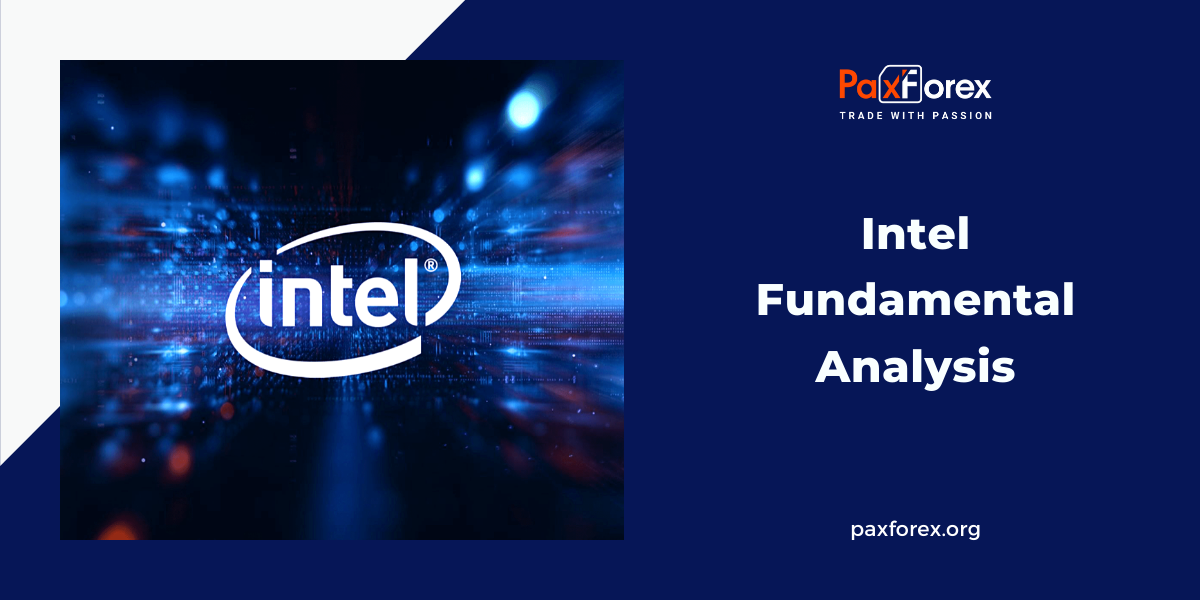
Source: PaxForex Premium Analytics Portal, Fundamental Insight
Intel, the prominent chip industry leader, has encountered a string of challenges that significantly impacted its stock performance in recent years. Most notably, the company relinquished its manufacturing supremacy to TSMC. Persistent delays and strategic misjudgments, combined with TSMC's consistent advancements, have placed Intel in an unexpected predicament compared to a decade ago.
These manufacturing setbacks at Intel provided an opportunity for its competitor, Advanced Micro Devices (AMD), to seize market share in both the PC and server chip segments. AMD has been successfully delivering high-quality products, and a crucial factor in its resurgence has been its access to cutting-edge manufacturing technology through its partnership with TSMC.
Furthermore, compounding Intel's challenges, the PC industry continues to grapple with a profound downturn. After experiencing a surge in demand during the pandemic, global PC shipments plummeted by a staggering 16.5% in 2022, and indications point toward another decline this year. The PC supply chain has been grappling with excessive inventories, resulting in reduced orders for Intel's semiconductor products. The situation deteriorated to the extent that Intel reported its most substantial quarterly loss ever in the first quarter of 2023, with revenue experiencing a sharp decline.
Despite these bleak financial results, investor sentiment towards Intel has seen a resurgence this year. Intel's shares have surged by approximately 44% year-to-date, outperforming the S&P 500. Intel's long-term prospects offer numerous favorable aspects, making the stock an attractive option for investors with a long-term perspective.
The future trajectory of Intel hinges on the successful revival of its manufacturing operations. Under the leadership of CEO Pat Gelsinger, Intel has embarked on a costly mission to directly compete with third-party foundries like TSMC, simultaneously striving to regain market share in its core PC and server CPU segments. Intel's ambitious strategy involves the rollout of five process nodes within a four-year timeframe, with the ultimate aim of surpassing TSMC by the conclusion of this roadmap.
Progress thus far has been promising. This year, Intel is poised to introduce its Meteor Lake PC chips, utilizing its Intel 4 process, marking the second step in its strategic roadmap. The following year will see the launch of Granite Rapids and Sierra Forest, two families of server CPUs manufactured on the Intel 3 process. By the close of 2024, Intel anticipates the readiness of the final two nodes, Intel 20A and Intel 18A, for production. Intel 18A is anticipated to outperform TSMC, assuming all goes according to plan.
The significance of regaining a manufacturing advantage is twofold. Firstly, it nullifies AMD's current advantage, which utilizes TSMC's advanced manufacturing technology. Secondly, it positions Intel to attract foundry customers seeking the most advanced process node available, including smartphone chip manufacturers like those powering Apple's devices and companies in need of AI accelerators.
While Intel's Intel 18A node may not yield substantial revenue until at least 2025, the company has already secured customers such as MediaTek and Ericsson. Furthermore, it recently received a substantial prepayment from an undisclosed customer to secure manufacturing capacity and expedite the development of Intel's facilities in Arizona.
Intel is also targeting foundry customers requiring mature, cost-effective process nodes for simpler chips. The company has entered a partnership with Tower Semiconductor to offer manufacturing capacity and foundry services for Tower's 65nm chips. Additionally, Intel has garnered support from major third-party chip design tool providers for its mature Intel 16 process.
Although the fruition of these endeavors may take a few years, the long-term potential is substantial. Projections indicate that the foundry services market is set to exceed $200 billion by 2028.
Intel's narrative will unfold over several years, and the company is currently on course to meet its process node launch timelines. In fact, Intel 18A is even ahead of its original schedule, which initially aimed for a 2025 release.
While there's always a window for unforeseen challenges, it seems that Intel has overcome its manufacturing hurdles. The substantial prepayment for Intel 18A capacity signals that at least one major customer has placed confidence in Intel's ability to deliver on its commitments.
Assigning a precise value to Intel stock proves challenging. The company's earnings are currently underwhelming, yet the foundry business holds significant potential for substantial long-term growth. As things stand, TSMC boasts a market capitalization nearly three times that of Intel. However, as Intel fortifies its position in the foundry sector, this gap is likely to narrow.
Intel faces a substantial journey ahead to successfully execute its manufacturing roadmap and attract foundry customers, particularly when competing directly with deep-pocketed players such as AMD and Nvidia. Nonetheless, if Intel can establish a prosperous foundry business, the stock has the potential to generate substantial returns for investors with a long-term perspective.
As long as the price is above 35.00, follow the recommendations below:
- Time frame: D1
- Recommendation: long position
- Entry point: 37.88
- Take Profit 1: 40.00
- Take Profit 2: 42.00
Alternative scenario:
If the level of 35.00 is broken-down, follow the recommendations below:
- Time frame: D1
- Recommendation: short position
- Entry point: 34.00
- Take Profit 1: 32.00
- Take Profit 2: 30.00













